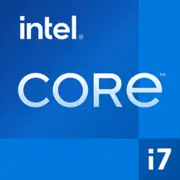Intel Core i7-4770TE

Intel Core i7-4770TE: An Obsolete Warrior or a Budget Solution in 2025?
Updated: April 2025
Key Features: Haswell Architecture and Modest Power
The Intel Core i7-4770TE processor, released in 2013, is based on the Haswell microarchitecture (4th generation Core). This 22nm chip has 4 cores and 8 threads thanks to Hyper-Threading technology. The base frequency is 2.3 GHz, with Turbo Boost up to 3.3 GHz. The L3 cache size is 8 MB, which seems modest for multitasking tasks in 2025, but it is still functional.
Key Features:
- Intel HD Graphics 4600 — integrated graphics supporting DirectX 11.1 and 4K output (via DisplayPort).
- Energy Efficiency Technologies — with a TDP of 45W, it is one of the "coolest" in the i7 line of that generation.
- Virtualization Technology (VT-x) — useful for creating virtual machines.
Performance:
According to Geekbench 6 (2025), the processor scores 408 points in single-threaded and 660 points in multi-threaded modes. In comparison, the modern budget Intel Core i3-13100 (2023) shows ~1800 (Single) and ~6000 (Multi). However, for basic tasks, the i7-4770TE is still quite capable.
Compatible Motherboards: The Hunt for Rarities
The processor uses the LGA1150 socket, limiting motherboard options to models released between 2013 and 2015. Relevant chipsets include:
- H81, B85 — budget options with basic functionality.
- H87, Q87 — RAID support with more SATA 6 Gb/s ports.
- Z87 — overclocking support (though the multiplier is locked for the i7-4770TE).
Examples of Motherboards:
- ASUS H81M-K — a mini-board with HDMI, priced at $50–$70 for remaining stock.
- Gigabyte GA-Z87X-UD3H — a top model with USB 3.0 and SATA Express (priced at $80–$100).
Selection Tips:
- Look for boards with updated BIOS for compatibility with Windows 11 (requires UEFI and Secure Boot).
- Check the condition of capacitors — older boards often suffer from bulging.
Memory: DDR3 and Its Limitations
The processor only supports DDR3-1333/1600 MHz in dual-channel mode. The maximum capacity is 32 GB (depending on the motherboard).
Recommendations:
- Use 2 modules of 8 GB (16 GB total) — this is optimal for multitasking.
- Avoid cheap RAM without heatsinks — DDR3 is sensitive to overheating under prolonged load.
Important: DDR4/DDR5 are not supported. This is the primary limitation for upgrades.
Power Supply: Minimum Watts, Maximum Reliability
With a TDP of 45W, the processor does not require a powerful PSU. For systems without a discrete graphics card, a 300–400W unit will suffice.
Configuration Examples:
- Office PC: Be Quiet! System Power 10 350W ($45).
- With GPU (e.g., GTX 1650): EVGA 450 BR ($55).
Tip: Don’t skimp on the PSU for older systems — low-quality units can damage components.
Pros and Cons: A Look After 12 Years
Pros:
- Low power consumption — ideal for media centers or quiet PCs.
- Integrated graphics — HD 4600 handles 4K YouTube and light gaming (e.g., CS:GO on low settings).
- Availability on the secondary market — the processor can be found for $30–$50.
Cons:
- Outdated architecture — a 40–50% IPC deficit compared to modern processors.
- No support for PCIe 4.0, USB 3.1, NVMe (only via adapters).
- Limited upgrade potential — the LGA1150 socket is "dead."
Usage Scenarios: Where is It Still Relevant?
1. Office Tasks: Document work, browsing, Zoom.
2. Media Centers: Streaming video, music, HTPC (with HDMI 1.4).
3. Light Gaming: Indie games (Hollow Knight, Stardew Valley) or older AAA titles (Skyrim, GTA V on medium settings).
4. Server Tasks: NAS, home server based on Proxmox or Docker.
Real-World Experience:
A user from Reddit built a mini-PC with an i7-4770TE, SSD, and 16 GB DDR3. The system works as a media center with Kodi and retro game emulators (up to PS2).
Comparison with Competitors: A Battle of Generations
- AMD A10-7850K (2014): Weaker in multi-threading (Geekbench 6 Multi ~500), but better graphics (Radeon R7).
- Intel Core i5-6500T (2015): More modern 14nm Skylake, but only 4 threads.
- Raspberry Pi 5 (2023): ARM system for $80. More powerful in energy efficiency, but weaker in x86 tasks.
Conclusion: The i7-4770TE is superior to its contemporaries due to Hyper-Threading but falls behind even budget newcomers in 2025.
Practical Assembly Tips
1. SSD is a Must: Kingston A400 480 GB ($35) will eliminate the "slowdowns" of HDD.
2. Cooling: Even the stock cooler is adequate, but for silence, consider the Arctic Freezer 7 X ($20).
3. Motherboard: Look for models with USB 3.0 and HDMI.
4. Don’t Overpay: The entire system should cost no more than $150–$200 (without a monitor).
Final Conclusion: Who is the i7-4770TE Suitable for in 2025?
This processor is a choice for:
- Budget build enthusiasts looking to revive old components.
- Media center owners where silence and low power consumption are critical.
- Offices where heavy software use is not required.
Why not to choose it? If you need a modern gaming system or work with 4K video — even the Intel Core i3-13100 ($120) will be orders of magnitude more powerful.
The i7-4770TE is an example of "surviving" hardware that, despite its age, can still provide value in niche scenarios. But its twilight has already arrived.
Basic
CPU Specifications
Memory Specifications
GPU Specifications
Benchmarks
Compared to Other CPU
Share in social media
Or Link To Us
<a href="https://cputronic.com/cpu/intel-core-i7-4770te" target="_blank">Intel Core i7-4770TE</a>